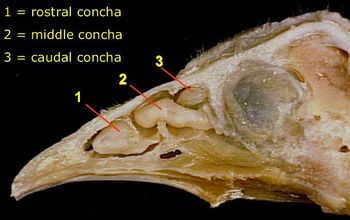Difference between revisions of "Avian Respiration - Anatomy & Physiology"
Jump to navigation
Jump to search
(New page: {{toplink |backcolour = FAFAD2 |linkpage =Cardiorespiratory System - Anatomy & Physiology |linktext =Cardiorespiratory System |maplink = Cardiorespiratory (Content Map) - Anatomy & Physiol...) |
|||
| Line 12: | Line 12: | ||
==Introduction== | ==Introduction== | ||
| − | + | The avian respiratory system contains some fundamental changes to the mammalian system. | |
| − | |||
| − | == | + | ==Avian Nasopharynx and Oropharynx== |
| + | |||
| + | *The nostrils of the bird, which lead into the nasal cavity, may have a flap of horn to protect them, known as the ''Operculum''. | ||
| + | *The Oral Cavity and the Nasal Cavity of the bird are interconnecting via a slit in the hard palate called the ''Choana''. | ||
| + | *The | ||
| + | [[Image:Avianheadsaggitalsection.jpg|right|thumb|350px|©Nottingham 2008 ''Saggital Section of an Avian skull showing the conchae.]] | ||
| − | |||
| − | |||
| − | |||
==Function== | ==Function== | ||
Revision as of 14:22, 13 August 2008
|
|
Introduction
The avian respiratory system contains some fundamental changes to the mammalian system.
Avian Nasopharynx and Oropharynx
- The nostrils of the bird, which lead into the nasal cavity, may have a flap of horn to protect them, known as the Operculum.
- The Oral Cavity and the Nasal Cavity of the bird are interconnecting via a slit in the hard palate called the Choana.
- The
Function
Vasculature
Innervation
Lymphatics
Histology
Species Differences
Links
References
- Dyce, K.M., Sack, W.O. and Wensing, C.J.G. (2002) Textbook of Veterinary Anatomy. 3rd ed. Philadelphia: Saunders.
